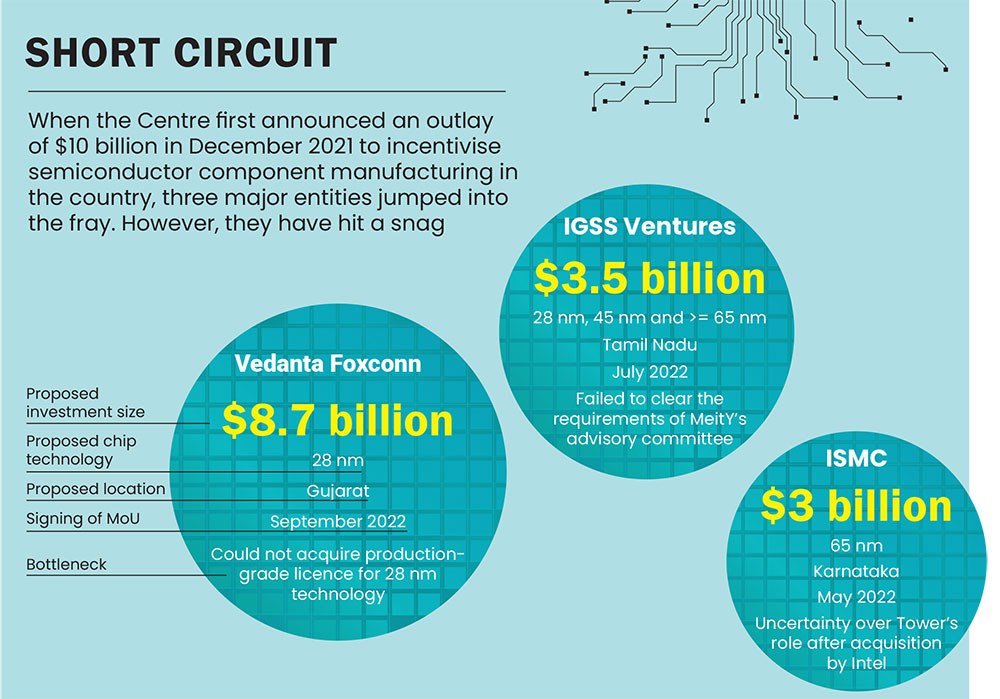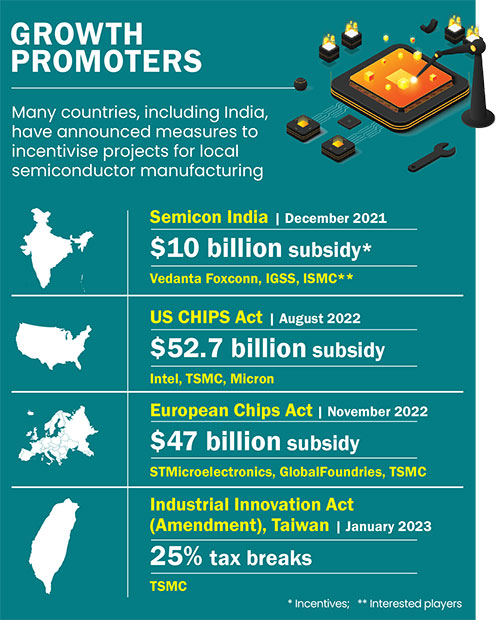FOMO, or the fear of missing out, in an era defined by the rush to increase one’s self-reliance and economic capabilities is playing out at the macroeconomic level. Today, every country worth its salt wants semiconductor factories within its borders. India, with its high-octane pitch under Prime Minister Narendra Modi to become a developed nation, can ill afford to miss this bus.
In December 2021, India announced its $10 billion incentive programme to attract semiconductor players to set up shop in India. But, so far, it has just one assembly unit and no chip foundries. Three entities—Israel’s Tower Semiconductor, Taiwan’s Foxconn and a consortium from Singapore—had expressed interest in partnering in manufacturing chips in India. However, all of them seem to have hit a snag.
The most ambitious of these would have to be the one by Foxconn, announced as a joint venture with billionaire Anil Agarwal’s Vedanta. However, Vedanta Foxconn Semiconductors Limited (VFSL), as the joint venture was called, could not acquire ready-to-manufacture technology for its proposed 28 nm semiconductor foundry. It had signed deals for investment of around $19.5 billion in Gujarat.

International semiconductor consortium ISMC, a joint venture of Israel-based Tower Semiconductor and Abu Dhabi-based Next Orbit Ventures, was looking at an investment of approximately $3 billion. However, the project is in limbo after Tower’s acquisition by US-based chip major Intel left question marks over the signing of binding agreements with its partner. Separately, a consortium led by Singapore-based IGSS Ventures, which was to invest $3.5 billion in semiconductor manufacturing in India, dropped out of its earlier bid after failing to secure the required technology transfer.
VFSL did get its hands on research-stage 28 nm agreement with Belgium-based IMEC, but it will take a while before the joint venture can take it to high-volume manufacturing stage. “We expect a 36-month effort to achieve our 28 nm objectives,” Vedanta Foxconn Semiconductors Ltd (VFSL) CEO David Reed tells Outlook Business. VFSL plans to set up a capacity of 40,000 wafers per month in its proposed 40 nm plant in Gujarat.
The importance of semiconductors was visible during the Covid-19 pandemic, when supply chain disruption brought automotive and consumer electronics industries across the world to a standstill.
“Setting up of semiconductor manufacturing facilities in India […] will bring down vulnerability on supply chains while also leading to drop in prices of chips,” says Pushan Sharma, director of research at CRISIL Market Intelligence and Analytics.
The Modi government’s dream of aatmanirbharta (self-reliance), for which it has allocated production linked incentives (PLIs) worth Rs 1.97 lakh crore across 14 sectors, cannot come true without the fodder of domestically manufactured semiconductors.
The market for semiconductors in India is expected to touch $64 billion by 2026, from its 2019 size of $22.7 billion, according to a report by Counterpoint Research and the India Electronics & Semiconductor Association (IESA). The reliance on imported chips will take a toll on India’s import bill and its current account deficit, which accounted for 2.2% of its GDP at $18.2 billion in the December quarter of FY23, as per the latest RBI data.
The Big Plans
India’s $10-billion incentive programme is aimed at manufacturing semiconductor chips with 65 nm, 45 nm, 28 nm and more advanced technologies. Nanometer (nm) in semiconductors refers to the size of each transistor on a single silicon wafer—the lesser the sizer, the more advanced and expensive the technology. However, the programme was initially shaped in a way that it favoured the relatively more advanced technology of 28 nm chips over 45 nm and 65 nm. While the former was promised fiscal support of up to 50% of the total project cost, the support for the other two was capped at 40% and 30% respectively. In October 2022, the Centre made it uniform at 50% across technology nodes.
India’s Challenges
Indian companies have neither the experience nor any reputation of producing quality products in the high-end category, both prerequisites for setting up foundries. Sensing the apprehensions of foreign firms, the Centre reopened the window for fab applications, with explicit encouragement to fabs for more mature (technologically older) nodes in June 2023.
“The government got relevant feedback from the industry that in overall semiconductor consumption, the majority of the consumption lies with more mature nodes,” says Sanjay Gupta, chairman of IESA. “It was a wise decision by the government to give the [same] subsidy across nodes,” he adds. Others point out that it was a waste of time, considering that there is limited interest for setting up 28 nm fabs in India.
Arun Mampazhy, an independent semiconductor expert who previously worked at pure-play chip manufacturer Global Foundries, says, “India knew in March 2022 that companies have not shown interest [for 28 nm nodes]. It took us one year and three months just to change this [application window]. It should have happened within two weeks. In semiconductors, two years is a long time.” For leading global foundries to set up shop in India, it is important to have an entire ecosystem in place, feels Mampazhy.
But the bigger question for policymakers would be: why the incentive route and not FDI? It is counterintuitive to suggest that this would be yet another attempt at making a success of Make in India initiative, simply because the West is wary of tech transfer to India and the latter has shown its inability to develop it at home.
The investment of having local chip supply chains instead of global ones will be massive. “If every country wants to be self-sufficient in semiconductors, incremental upfront investment of at least $1 trillion is required,” says Raj Varadarajan, senior partner at Boston Consulting Group (BCG). Such a scenario will result “in a 35% to 65% overall increase in semiconductor prices and ultimately higher costs of electronic devices for end users,” according to a BCG report.

Navigating Geopolitics
Just months after India came out with its semiconductor policy, the US signed its CHIPS Act into law in July 2022 with an incentive package of $52 billion. The European Commission also approved its EU Chips Act this year with a $47 billion subsidy package.
Although both these moves have been criticised for promoting trade protectionism, the huge incentives are reflective of the West’s bid to cut down its reliance on Asia. Even within Asia, countries like Vietnam and South Korea have offered incentives such as lucrative tax breaks to attract major chipmaking firms. The US, Europe and South Korea also have the benefit of having homegrown companies already playing decisive roles in the global chip supply chain. For India to find its space, it will have to forge the right kind of partnerships.
While China’s semiconductor industry keeps burgeoning—from having around 1,300 registered companies in 2011 to more than 22,000 by 2020—the US government is pursuing a series of trade restrictions that will cut off Chinese companies from American chip technology. Other countries have also joined hands with the US to limit the export of advanced chip-making technology to China.
In January 2023, India and the US had the inaugural meeting of the US-India initiative on Critical and Emerging Technology, where it was announced that they would collaborate on enhancing resilient semiconductor supply chains. The two nations also signed a memorandum of understanding regarding this in March 2023. The collaboration found success recently when US-based Micron Technology’s proposal to set up a semiconductor assembly and testing unit in Gujarat was approved by the Union Cabinet in June.
Ghosts of The Past
Lack of sufficient infrastructure is a major hurdle, Varadarajan says. But along with that, India seems to be suffering a challenge in terms of credibility as well. Its legacy of policy flip-flops and the retrospective tax dispute that India picked up with British telecom major Vodafone did not help the country’s reputation among global brands.

More recently, Korean company Samsung Electronics has been at loggerheads with the government over claims worth Rs 900 crore under the smartphone manufacturing PLI scheme. The company has been denied incentives under the scheme over “discrepancies” in the invoices generated for the fiscal year 2021.
“From Vodafone to Cairn Energy to Samsung, we manage to deal with foreign investors roughly and scare them away from making high-risk investments,” says an economist who is studying India’s PLI schemes across sectors.
Then there is the issue of capital. Despite a lucrative incentive programme offered by the government, there are very few Indian companies that have the wherewithal to enter this sector. So far, only Vedanta group has made the most daring announcement and even that company has no experience of manufacturing anything in the country, forget doing it on such a large scale.
The government is hopeful, though. According to an official involved in the formulation of India’s current semiconductor policy, the government has reduced 39,000 compliance processes to enhance the ease of doing business in the country. The setting up of special economic zones and investment regions is also expected to help with the infrastructure needs of the industry.
The government is also focusing on design-linked incentives for Indian start-ups. However, industry insiders say that getting chip designing companies to India will not be easy. “Firstly, the design scheme is just for start-ups where the government’s intention is right as it wants intellectual property creation in India. But we do not have the talent to do design in India and then sell it,” says a private consultant, requesting anonymity.
There is a general belief that a large proportion of chip designing happens in India, but in reality, the entire value-chain is dependent upon specifications given from headquarters in the US, he says. “You can get Indian talent to do some additional design based on specs [specifications] from the headquarters abroad, but it is very difficult if you want them to design a chip from scratch and then do marketing and sales to OEMs in Japan, Europe or US,” the consultant elaborates.
Even under the design-linked incentives, the Centre went from offering 30% fiscal support in 2021 to 50% in 2022.
With different schemes for semiconductor fabrication facilities, chip design, compound semiconductors, chip assembly, testing, marking and packaging facilities or outsourced semiconductor assembly and testing facilities, India has made it clear that it wants all the segments of the chip supply chain in the country.
Getting it Right
After having almost tripled its electronic exports from $5.8 billion to $16 billion between 2015 and 2022, India is now targeting $120 billion electronics exports by 2026.
Those at the helm believe that such a drastic rise in manufacturing and exports will signal the success of its aatmanirbharta campaign. However, the government is already facing criticism from several quarters that the rise in electronics exports is largely due to increased assembly plants, which offer low value addition when viewed against the entire electronics value chain. Similar criticism can now be expected against the assembly and testing plant that Micron plans to establish in Gujarat.
To silence this criticism once and for all, India will have to successfully establish a semiconductor ecosystem as soon as possible. Will India once again miss out on the opportunity to turn itself into a globally important manufacturing hub? Or will the Modi government break the jinx and catapult India as a Vishwa Guru? The answer will depend on the realisation of India’s semiconductor dreams.











